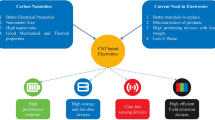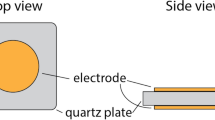Abstract
Many studies have been conducted on the use of nano field-effect transistor (nanoFET) sensors for the detection of biological species. However, the practical application of nanoFET-based biosensors is difficult because their operating principle has not been clarified. Most existing studies focused on ion concentration and pH level in a solution, the Debye length (the physical distance at which charged particles affect the electric field), and the surface potential of the gate electrode of the nanoFET device. In this study, we verified the operating principle of the nanoFET biosensor with an extended gate electrode and established an equivalent circuit. We experimented using a solution with different pH levels to demonstrate the operating principle of the sensor. Additionally, we analyzed the responses of the device based on the material of the extended gate electrode, the effects of the reference electrode, and the connection configuration of the electrodes. We derived an equivalent circuit to explain how the nanoFET sensor works. The analysis results show that the operating principle of measuring pH or biomolecules depends on the change of the polar capacitor in the liquid-electrode interface on the surface of the sensing electrode. The roles of the reference and extended gate electrodes were clearly explained in this paper. The results of this research will improve the understanding of the operating principle of nanoFET-based biosensors and accelerate the studies for practical biosensor applications of nanoFET devices.





Similar content being viewed by others
References
Schöning, M.J. & Poghossian, A. Recent advances in biologically sensitive field-effect transistor (Bio-FETs). Analyst 127, 1137–1151 (2002).
Star, A., Garbriel, J.P., Bradley, K. & Gruner, G. Electronic detection of specific protein binding using nanotube FET devices. Nano Lett. 3, 459–463 (2003).
Lee, C.-S., Kim, S.K. & Kim, M. Ion-sensitive field-effect transistor for biological sensing. Sensors 9, 7111–7131 (2009).
Pachauri, V. & Ingebrandt, S. Biologically sensitive field-effect transistors: from ISFET to NanoFETs. Essays Biochem. 60, 81–90 (2016).
Kaisti, M. Detection principles of biological and chemical FET sensors. Biosens. Bioelectron. 98, 437–448. (2017).
Lowe, B.M., Sun, K., Zeimpekis, I., Skylaris, C. & Green, N.G. Field-effect sensors — from pH sensing to biosensing: sensitivity enhancement using strep-tavidin-biotin as a model system. Analyst 142, 4173–4200 (2017).
Vu, C. & Chen, W. Field-effect transistor biosensors for biomedical applications: recent advances and future prospects. Sensors 19, 4214 (2019).
Park, S., Kim, M., Kim, D., Kang, S.H., Lee, K.H. & Jeong, Y. Interfacial charge regulation of protein blocking layers in transistor biosensor for direct measurement in serum. Biosens. Bioelectron. 147, 111737 (2020).
Batista, P.D. & Mulato, M. ZnO extended-gate field-effect transistor as pH sensors. Appl. Phys. Lett. 87, 143508 (2005).
Goda, T. & Miyahara, Y. Label-free and reagent-less protein biosensing using aptamer-modified extended-gate field-effect transistor. Biosens. Bioelectron. 45, 89–94 (2013).
Das, A., Ko, D.H., Chen, C.-H., Chang, L.-B., Lai, C.-S., Chu, F.-C., Chow, L. & Lin, R.-M., Highly sensitive palladium oxide thin film extended gate FETs as pH sensor. Sens. Actuators, B. 205, 199–205 (2014).
Guan, W., Duan, X. & Reed, R.A. Highly specific and sensitive non-enzymatic determination of uric acid in serum and urine by extended gate field effect transistor sensors. Biosens. Bioelectron. 51, 225–231 (2014).
Minamiki, T., Minami, T., Kurita, R., Niwa, O., Wakida, S., Fukuda, K., Kumaki, D. & Tokito, S. A label-free immunosensor for IgG based on an extended-gate type organic field effect transistor. Materials 7, 6843–6852 (2014).
Chin, Y.L., Chow, J.-C., Sun, T.-P., Liao, H.-K., Chung, W.-Y. & Hsiung, S.-K. A novel SnO2/Al discrete gate ISFET pH sensor with CMOS standard process. Sens. Actuators, B. 75, 36–42 (2001).
Yin, L.T., Chou, J.C., Chung, W.Y., Sun, T.P., & Hsiung, S.K. Study of indium tin oxide thin film for separative extended gate ISFET. Mater. Chem. Phys. 70, 12–16 (2001).
Nguyen, T.N.T., Seol, Y.G., Lee, N.E., Organic field-effect transistor with extended indium tin oxide gate structure for selective pH sensing. Org. Electron. 12, 1815–1821 (2011).
Reddy, B., Dorvel, B.R., Go, J., Nair, P.R., Elibol, O.H., Credo, G.M. Daniels, J.S., Chow, E.K.C., Su, X., Varma, M., Alam, M.A. & Bashir, R. High-k dielectric Al2O3 nanowire and nanoplate field effect sensors for improved pH sensing. Biomed. Microdevices 13, 335–344 (2011).
Sun, K., Zeimpekis, I., Hu, C., Ditshego, N.M.J., Thomas, O., Planque, M.R.R., Chong, H.M.H., Morgan, H. & Ashburn, P. Effect of subthreshold slope on the sensitivity of nanoribbon sensors. Nanotechnology 27, 285501 (2016).
Minot, E.D., Janssens, A.M. & Heller, I. Carbon nanotube biosensors: The critical role of the reference electrode. Appl. Phys. Lett. 91, 093507 (2007).
Seo, Y.-T., Lee, K.-N., Jang, K.J., Lee, M.-H., Lee, H.S., Seong, W.K. & Kim, Y.-K. Negative ions detection in air using nano field-effect-transistor (nanoFET). Micro Nano Sys. Lett. 2, 7 (2014).
Lee, K.-N., Seo, Y.-T., Kim, Y.-K., Yoon, S., Lee, M.-H. & Seong, W.K. Detection ions in air using a nano field-effect transistor (nanoFET). Microelectron. Eng. 158, 75–79 (2016).
Lee, K.-N., Seo, Y.-T., Yoon, S., Lee, M.-H., Kim, Y.-K. & Seong, W.K. Chemical gating experiment of a nano-field-effect transistor sensor using the detection of negative ions in air. Sens. Actuators, B 236, 654–658 (2016).
Kang, H.-L., Yoon, Su., Hong, D.-K., Kim, W.-H., Seong, W.K. & Lee, K.-N. I–V hysteresis characteristics of nano-field effect transistor (nanoFET) sensor with a floating metal gate electrode, Microelectron. Eng. 213, 35–40. (2019).
Acknowledgements
This work was financially supported by the research fund of Ministry of Trade, Industry, and Energy (Grant No. 10076874 and No. 10 077599), Republic of Korea.
Author information
Authors and Affiliations
Corresponding author
Additional information
Conflict of Interests
The authors declare no competing financial interests.
Rights and permissions
About this article
Cite this article
Kang, HL., Yoon, S., Hong, Dk. et al. Verification of Operating Principle of Nano Field-effect Transistor Biosensor with an Extended Gate Electrode. BioChip J 14, 381–389 (2020). https://doi.org/10.1007/s13206-020-4410-1
Received:
Accepted:
Published:
Issue Date:
DOI: https://doi.org/10.1007/s13206-020-4410-1




